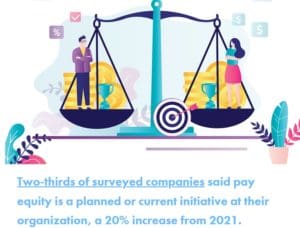Women are still receiving less compensation than men for doing the same jobs. How can organizations achieve pay equality?
By Zee Johnson
It’s no secret -women make up a large percentage of the global workforce. According to the U.S. Department of Labor, women account for 43.6% of all full-time employees and 63% of the part-time population. But even with this amount of female representation in the workplace, they’re still not seeing their fair share monetarily.
In 2020, the gender pay gap, an occurrence in which women are paid less than men and often for performing the same tasks, raged. A recent Pew research study revealed that overall, women earned 84% of what men earned and at the time that the research was performed, it would have taken women an additional 42 days of work to earn what men did.
Payscale’s Pay Equity Strategist Ruth Thomas says it’s unfortunately all too common for women to receive the short end of the salary stick, but certain groups face more disparities than others. “When you look at it by race and on an uncontrolled pay gap, the most disadvantaged group is American Indian/Native Alaskan women who receive 71 cents on the dollar based on what a White man makes,” Thomas says. “When you look on a controlled basis, where people are doing the same jobs in the same location, even there, the most disadvantaged group we see year-over-year is Black women. We’re not seeing any significant change or progress there.”
Markita Jack, head of diversity, equity, and inclusion at Iterable, also recognizes the disadvantages these specific groups experience, despite their skill sets, knowledge, and acumen. “Those that are facing the most significant pay gap today are not so different from before -women and minorities. But it’s when these two variables come together that we see the most significant gap,” Jack explains. “What this means is that women of color -American Indian and Native Alaskan women, Hispanic women, and Black women -are more likely to occupy lower paying jobs and are more likely to be paid less despite having the same level of experience as White men doing the same job.”
Some good news: Women have increased their presence in higher paying jobs that have been traditionally dominated by men, like professional and managerial positions. But in certain industries, women continue to make less.
Cianna Walker-Flom, diversity, equity and inclusion program manager at Ribbon, highlights the biases women face in a particular industry overrun by men -the tech sector. “Over half (59%) of the time, men get paid more than their women counterparts in the technology industry,” Walker-Flom says, citing Hired’s impact study.
And the gap doesn’t stop there. According to the U.S. Bureau of Labor Statistics, women doctors, who are also surgeons, experience the largest pay gap, making $43,000 less than men of the same profession.
Jack doubles down on tech’s compensation disconnect, explaining that the pandemic only worsened it. “The tech industry in particular has always had an incredible disparity in equal representation and equal pay. And what little progress was made before the pandemic was stifled (and, in some cases, lost) during the COVID-19 crisis, during which unemployment disproportionately affected women and people of color.”
Two years ago, the pandemic came and quickly turned lives and livelihoods upside down. While women were already twice as likely to experience negative impacts to their careers following life-altering events like birth or adoption, COVID-19 had an immense impact on career advancement for mothers who stayed home while schools and childcare facilities were closed. According to McKinsey’s Women in the Workplace study, mothers are more than twice as likely than fathers (24% versus 11%) to worry that their performance is being judged negatively because of caregiving responsibilities.
However, some HR leaders do think that there’s light at the end of the tunnel for the moms who had to pass on in-person work. Amy Mosher, chief people officer for isolved, believes remote work has opened the door for an even playing field.
“As we move into a new era of workplace norms, remote work has the potential to level out the pay gap by emphasizing a worker’s talents over their gender, race, or ethnicity. More transparent and accessible performance standards will improve pay equity as disparity has often existed in populations requiring a more flexible work environment,” Mosher says.
Cecilia McKenney, CHRO and SVP of Quest Diagnostics, asserts that when available, flexible work options ultimately allow more women to get ahead. “Because of the work we do at Quest Diagnostics, the lion’s share of our people work onsite. However, opportunities for remote work have expanded our access to great talent for roles that allow it,” McKenney says. “It allows for higher participation in the employment market overall and greater flexibility, and it is likely to benefit women, given their role as primary childcare provider in many instances.”
While some companies are implementing improvements to their work models, Payscale’s Thomas says that businesses should be aware of some potential negatives lurking around the concepts of remote and hybrid work. “There’s a risk for something called proximity bias, where, if you’re not in the office and you’re not getting face-to-face contact, then that may affect assessments or even being allocated key work assignments. That’s a potential negative.”
There’s Work to Be Done
Thankfully, pay equity seems to be quickly making its way onto company radars. Payscale’s 2022 Compensation Best Practices Report revealed that two-thirds of surveyed companies said pay equity is a planned or current initiative at their organization, a 20% increase from 2021.
One way for businesses to start the process of ensuring that women and minority employees are compensated fairly is by performing a pay equity analysis. This internal audit that measures pay rates and assesses any pay differences based on a range of criteria, including:
- age;
- race;
- gender; and
- job description.
Tanya Jansen, co-founder of beqom, says that a pay analysis and the data that comes from it can identify gaps and eliminate them. “The first step any company should take if they believe there is a pay bias present is to evaluate their own compensation practices and conduct a pay analysis with all factors and attributes from gender, age and race, to performance, tenure, and location. After conducting a thorough pay equity analysis, leaders must further analyze the data to understand where human bias may persist and contribute to gaps,” Jansen says. “This mass volume of data is key to helping companies close gaps because it provides all the possible information on pay data to uncover the gaps in the first place.”
Thomas thinks pay analyses are an effective way for organizations to determine their next steps. “Unless you understand where your gaps are, you can’t really diagnose which actions are required,” she says. “Most organizations have uncontrolled pay gaps which are more representative of what we call the opportunity gap -the general barriers that different groups of employees face and that prevents them from entering certain roles and progressing through an organization.”
Additional Payscale research outlines how organizations can effectively perform an analysis in six straightforward steps.
- Retrieve data. Collect basic information like current employment status, historical employment information, demographic information (gender, race, age), job title, pay range, etc.
- Clean it up. Determine how this data will be grouped. By location? Department? Full or part-time status? Also see which factors can rightfully justify any pay differences.
- Analyze. Pay attention to job titles and compensable factors like years of experience and skill set. Ensure compensation is at least in line with the market and if not, update it.
- Interpret. Many questions will arise at this point in the process including, are there any hidden pay gaps? Why is this overachieving employee with adequate experience at the bottom of the range, while this poor-performer with less experience is at the top?
- Talk to leadership. Report any notable findings and any recommendations to executives.
- Share with employees. Prompt all employees directly affected by pay disparities and make pay adjustments immediately.
Utilizing technology can help organizations not just perform a pay analysis, but also ensure that it is free of human bias.
“There are a variety of ways that technology can successfully eliminate pay inequalities, but one of the most critical ways is utilizing automation to remove bias from compensation decisions,” Jansen says. “Employees should have clear and transparent metrics that feed into these decisions and create a realistic picture of whether they are meeting the expectations of the role, what their pay should be when meeting those expectations and what it will take to get promoted. These clear expectations should allow for easily automated compensation decisions.”
Take a Look at Company Culture
Paying women equally for the same time, effort, and expertise it takes to perform their duties as their male counterparts ultimately comes down to an organization’s inclusion initiatives. When companies stop or reverse negatives trends, like a culture lacking DE&I, then paying women fairly will no longer be a second thought.
“We have a policy that is a commitment to a diverse workforce and equitable compensation,” McKenney explains. “As part of our journey to continue to build an inclusive and performance-oriented culture, equitable compensation and benefits are central to our employee value proposition.”
Walker-Flom also believes that a truly diverse organization will always compensate fairly. “At Ribbon, we’ve identified pay equity and transparency as a DEI best practice,” she says. “[We don’t] negotiate salary; all employees are automatically paid above the market rate for their role. We believe that organizations should start by having equitable policies in place followed by implementing a strategy to target historically excluded candidates in recruiting, not the other way around.”
For Jack, she believes it’s the company’s job to provide a fair and equitable workplace, but the employees’ job to hold them to their promises. “Business leaders make diversity a corporate priority or core value. You have the power to transform the perception of your organization. Ensure your business is designed to support a diverse workforce before you attract one,” she says. “And for employees, hold your workplace accountable. You have more leverage now than ever before. Use that leverage to demand equity.”
















